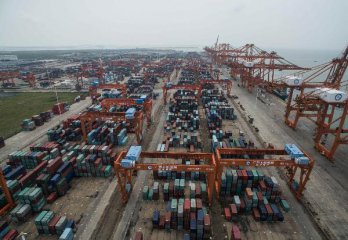
China's trade rebounded in November, with exports and imports both up significantly, but risks of receding trade globalization might weigh on future growth.
Exports in yuan terms rose 5.9 percent year on year in November, ending previous drops, while imports continued to pick up steam by increasing 13 percent, customs data showed on Thursday.
Stripping out the impact of yuan depreciation, exports in U.S. dollar terms edged up 0.1 percent year on year in November while imports gained 6.7 percent.
China's trade surplus in dollar terms was 44.61 billion U.S. dollars, down from 49 billion U.S. dollars in October. The surplus is in contrast to a decline of 69.1 billion dollars in China's foreign reserves in November, which brings the nation's foreign exchange reserves to the lowest level since March 2011.
Stronger import figures were a positive sign on domestic demand and recent yuan depreciation also contributed to the rebound, said Niu Li, an economist with the State Information Center.
With the deepening of supply-side reform and a low price base, imports may sustain growth, he added. Foreign trade volume reached 2.35 trillion yuan (about 340 billion U.S. dollars) in November, with the trade surplus narrowing to 298 billion yuan, according to the General Administration of Customs (GAC).
Trade volume for the first eleven months dropped 1.2 percent from a year earlier to 21.8 trillion yuan while trade surplus shrank 5.8 percent to 3.1 trillion yuan.
Foreign trade with China's largest trade partner -- the European Union -- rose 3.1 percent in the first eleven months. In the same period, foreign trade with the United States, China's second-biggest trade partner, fell 1.7 percent, and that with ASEAN, its third-largest trade partner, gained 0.8 percent.
In addition to seasonal factors such as the approaching Christmas holiday, accelerated economic growth in the United States and stronger manufacturing sectors in the euro zone contributed to China's export growth, said a report by China Merchants Securities Thursday.
Customs data showed that exports of machinery and electronic products as well as goods in labor-intensive sectors such as textiles and toys posted declines in the first eleven months, and private firms still led the country's exports.
Meanwhile, imports of large commodity goods including iron ore and crude oil continued to grow in the January-November period with general price drops, data showed.
The positive reading is also attributable to the country's improving fundamentals and recovering commodity prices of crude oil, iron ore and nonferrous metals in the global market in November, said Zhu Qibing, an analyst with BOC International.
An official index predicting future trade growth prospects began to rise again in November, climbing by 1.3 points from the previous month.
China's foreign trade will continue to improve as the global economy will do better next year, but downward pressure for trade growth still remains for the coming year due to a variety of uncertainties including possible trade policy changes by the U.S. government, said Zhu.






















Latest comments